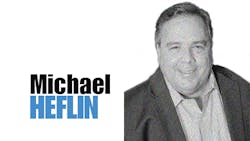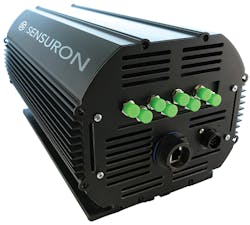Interview: FOS—A Game Changer in Data Testing
This file type includes high resolution graphics and schematics when applicable.
My role is CEO, I have been with Sensuron just over a year, and I joined the company for the purposes of spinning out Sensuron, our fiber-optic sensing (FOS) division, out of 4DSP.
4DSP has a long history of producing advanced data cards from digital and analog to field-programmable gate array (FPGA) and FPGA mezzanine cards. They are a world leader in this field, which is the foundation for their ongoing nine-year relationship with NASA. I have 30 years in the industry of working with hardware, software, and services companies; basically the full gambit of technology spectrum.
When was Sensuron established?
About 11 years ago, NASA’s Helios unmanned aircraft vehicle broke apart over the Pacific Ocean, and after the crash, NASA faced a specific problem. They had innovated beyond their ability to test. The aircraft had a great design and a lot of potential, but its crash set them off on a mission to determine how they could test their design beyond their conventional and old technologies to test and monitor. A group out of Langley and Armstrong Research centers began to investigate the best method of testing and settled on fiber-optic sensing. That led them to need some advanced data-processing cards that started the relationship with 4DSP.
Five years ago, a significant improvement to FOS technology allowed a significant number of sensors to be processed simultaneously. The consequence of that was a more granular collection of test data that catapulted the FOS technology forward. NASA has licensed the technology directly, which allowed us, instead of testing in lab, to build a commercialized product.
Watch NASA's Fiber Optics Sensing System (FOSS) in the following video:
What kind of sensing does fiber-optic sensing provide?
Sensuron is not just a FOS company. We have developed the world’s most advanced fiber-optic sensing platform. The term platform means more than just applying a sensor to discover a specific set of data for a given task. FOS technology reaches beyond strain-gauge technology and allows you to place thousands of sensors on single fiber and multiple fibers on a single system. The system detects strain, temperature, 2D shape sensing, 3D shape sensing, pressure, magnetics, and with certain coding on fibers, chemical reaction sensing.
(Editor’s Note: FOS implements fiber Bragg grating (FBG) sensors. These sensors use reflections in the Bragg wavelength. A narrowband wavelength swept laser interrogates the FBG sensors as they respond to strain resulting from stress or pressure on the structure. A processing system measures strain at multiple locations along the length of the fiber while attached to the surface of a structure. The strain data results into displacement data, thereby displaying the shape and movement of the optical fiber. From these strain measurements, the system calculates 2D and 3D shapes, stress, temperature, pressure, strength, stiffness (bending and torsion), liquid level, and operational load.)
There are three generations of FOS technology: wavelength-division multiplexing (WDM), scattering, and optical frequency domain reflectometry (OFDR). Each one has their advantages and their places it plays very well but they are truly generations of the advancements of the technology. Our technology platform allows us you to do this wide spectrum of sensing which was difficult to accomplish with earlier technologies.
Sensuron is involved in fiber-optic sensing. What avenues of work can use FOS?
An example of the technology is FOS’s usage in an upcoming rocket launch. Our part of the mission is to monitor the cryogen fuel tank so that they can reduce the amount of fuel and increase the amount of payload.
In the medical industry, we are working with endoscopic tools and using the technology as a platform to understand what is occurring in the body with a single tool. It creates a tool that is much more pliable, flexible, and provides more data. In one example, it can provide pressure, visualization of what is occurring at the end of a catheter, or the 3D shape of an object in the body. That is accomplished with just one set of fibers off one integrator. If you think about a different medical application, they might not only want to know the temperature, but also the temperature to cauterize. Our system can give them a much more accurate picture of what temperature they are producing in order to perform a much more sophisticated surgery.
Sensuron is also a two-time NASA R&D 100 Finalist. What are your current projects with them?
This year’s R&D 100 Finalist award is for the new ruggedized RTS 125 FOS system. The two pieces of equipment you can see on our website (the RTS 125 and RTS 150) actually have the same inherent pieces of technology. The primary difference between them is that the RTS 125 is ruggedized. This allows it to be strapped to airplanes, rockets, or moved to a field type of environment. We have a client that will be using it as a tool for civil work to determine what is happening inside walls that may be bowing or deflecting. Both the RTS 125 and the RTS 150 are R&D 100 Finalists.
We are also involved in NASA’s Adaptive Compliant Trailing Edge (ACTE) project, which is their flex wing project. This allows a wing surface that can change shape in flight. FOS has been installed throughout the wing to measure strain, wing load, and deflection.
Do you see Sensuron entering the automation market?
We see ourselves being able to play in the civil market, such as roads, bridges, and buildings, as well as in the automotive and industrial-equipment industries. We have a couple of projects in the nuclear industry. Both of those projects are about testing and monitoring to help ensure safety in the plants. It has to do with the core concept that companies continue to innovate, and just like NASA 10 years ago, discovered that they had innovated beyond what they could test to a degree to ensure their innovation performed the way they desired. Today, people are looking for new technologies to be able to test out, monitor, and operate those innovations they are taking to market.
Does FOS have a future in the Internet of Things (IoT)?
Our system is capable of doing that today. We do not currently have it attached to a wireless network, but we built a system that is considered a smart system or platform. That system has a PC processor and memory inside all of its units. From our units, we can drive into other systems and other communication systems.
Today, on the commercial side, it has more to do with companies desire to continue to innovate around the demand of the customer base. A recent Forbes article said that IoT was not so much about the devices, but the roles played by sensors in IoT. I think sensor is a term we will hear over and over again in a number of different ways as we go through the next five to seven years. We are getting to the point with technology that it is not just data they want, but also the right data. They want it for a business purpose and not an observation purpose.
When you speak of sensing, most people think of point sensing. Regardless of the capabilities of the sensor, it delivers one message and one data point of what it is sensing. And the nature of what you produce will be one type of sensing, and you will have to use multiple sensors for different parameters (i.e. temperature, pressure, etc.). If you compare an entire point-sensing system to a FOS system, you will receive much more data using FOS versus your cost of the system.
In the aviation industry, we already see a demand. Rolls Royce is already trying to monitor data from an engine and transmit that data to the ground via satellite. On a commercial airplane, we can provide these types of functions. We could provide a structural health monitor, flight-control feedback, wing-load information, temperature information, and landing gear. You will find that those systems will become more common and sophisticated with lower cost points.
On the consumer side, future opportunities for FOS and IoT are wide open. An example is that we can take FOS fiber and put it within clothing. If FOS were inserted into spandex clothing, and if a person were to wear that clothing, you could fully identify everything about their body shape and type. That information could be saved on a thumb drive and uploaded onto a system that could create and order user-specific clothing.
This month’s Machine Design issue features our Salary Survey article (p. 26). As a CEO, how do you feel about young engineers entering the workforce?
It’s a great time to be an engineer. Recent studies done by the Austin Chamber and Technology Council showed 9% of our workforce is in engineering or related engineering fields. The challenge for engineers is if they will have the specific skill set that will allow them to land the best job. Different segments of engineering, software or hardware, are looking for people with the specific skills. In FOS, we need more students coming out of universities and technical schools that already understand how to apply fibers, read outputs, and how to use fiber as a platform.



